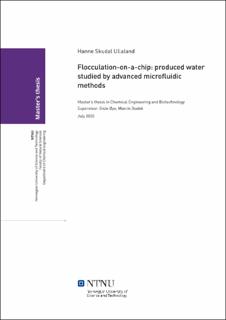| dc.contributor.advisor | Øye, Gisle | |
| dc.contributor.advisor | Dudek, Marcin | |
| dc.contributor.author | Ullaland, Hanne Skudal | |
| dc.date.accessioned | 2021-09-28T18:22:51Z | |
| dc.date.issued | 2020 | |
| dc.identifier | no.ntnu:inspera:57621272:36740457 | |
| dc.identifier.uri | https://hdl.handle.net/11250/2785359 | |
| dc.description.abstract | Produsert vann, bestående av dispergert olje, er et betydelig biprodukt fra oljeproduksjonen. Det er viktig å fjerne den dispergerte oljen fra det produserte vannet før det kan tømmes ut eller reinjiseres, og det produserte vannet må derfor behandles. En måte å forbedre effektiviteten av behandlingen på er å fremme fenomenene koalesens og flokkulering, som øker størrelsen av oljedråpene og forbedrer separasjonen. Dette kan oppnås ved tilsetning av produksjonskjemikalier til det produserte vannet, nemlig flokkulanter. Microfluidiks er en relativt ny metode som kan brukes til undersøkelse av råoljeemulsjoner og koalesens og flokkulering av oljedråper.
Dette prosjektet har som mål å undersøke forskjellige flokkulanter på råoljeemulsjonstabilitet med en mikrofluidisk metode; Universal Microfluidic Platform-apparatet. Dessuten å utvikle en metode for dynamisk endring av flokkulant konsentrasjonen i mikrofluidoppsettet. I tillegg har forskjellige metodologier for flokkulant- og emulsjons-karakterisering er blitt utført. Disse inkluderte målinger av størrelse, zeta-potensial og overflatespenning av flokkulantløsninger, og zeta-potensial, overflatepenning og reologimålinger av råoljeemulsjoner. Dessuten ble turbiditeten av råoljeemulsjoner målt over tid for å verifisere resultatene fra mikrofluidmetoden. Arbeidet er en fortsettelse av arbeidet som ble utført i emnet 'TKP4180 - Kjemisk prosessteknologi, fordypningsprosjekt', høsten 2019.
En råolje, fra norsk sokkel, ble brukt til å fremstille emulsjonene. Råoljeemulsjonene ble undersøkt med og uten tilsetning av åtte ulike kommersielle flokkulanter. Studiene viste at egenskaper som størrelse og zeta-potensial for flokkulantene spiller en rolle i emulsjonsstabiliteten. Tilsetningen av flokkulanter til råoljeemulsjonene påvirket også overflatespenningen og reologien. Fra eksperimentene som ble utført med mikrofluidteknikken ble det funnet at resultatene til en viss grad tilsvarer turbiditetsmålingene. En dynamisk endring av flokkulant konsentrasjonen gjorde det også mindre tidkrevende å utføre flere tester, med sammenlignbare resultater.
Det konkluderes med at mikrofluidteknikken er et godt alternativ for undersøkelse av emulsjonstabilitet og en dynamisk endring i flokkulant konsentrasjonen er en tilfredsstillende og tidseffektiv metode for å utføre eksperimenter med mikrofluidteknikken. | |
| dc.description.abstract | Produced water, consisting of dispersed oil, is a substantial by-product from the hydrocarbon production. It is essential to remove the dispersed oil from the produced water before it can be discharged or re-injected, and, therefore, it needs to be treated. One way to boost the efficiency of the treatment is to promote the phenomena of coalescence and flocculation, which increase the oil droplet sizes and improve the separation. This can be achieved by the addition of production chemicals to the produced water, namely flocculants. Microfluidics is a relatively new method that can be used for the investigation of crude oil emulsion stability and the coalescence and flocculation of oil droplets.
This project aims to investigate different flocculants effect on crude oil emulsion stability with a microfluidic method; the Universal Microfluidic Platform apparatus. And, to develop an approach for a dynamic change of the flocculant concentration in the microfluidic setup. In addition, several methodologies for flocculant and emulsion characterization have been performed. These included measurements of size, zeta potential and surface tension of flocculant solutions, and zeta potential, interfacial tension and rheology measurements of crude oil emulsions. Besides, the turbidity of crude oil emulsions was measured over time to verify the results from the microfluidic method. The work is a continuation of the work performed during the course 'TKP4580 - Chemical Engineering, Specialization Project' fall 2019.
A crude oil from the Norwegian Continental Shelf was used for preparation of emulsions. The crude oil emulsions were investigated with and without the addition of eight different commercial flocculants. The studies showed that properties as size and zeta potential of the flocculant solutions play a role in the emulsion stability. Also, the addition of flocculants to the crude oil emulsions slightly affected the interfacial tension and rheology. From the experiments performed with the microfluidic technique, it was found that the results do, to some degree, correspond to the turbidity measurements. Also, a dynamic change of the flocculant concentration made it less time consuming to perform several tests, with comparable results.
It is concluded that the microfluidic technique is a good option for the investigation of emulsion stability and that a dynamic change in the flocculant concentration is a satisfactory and time-effective method to perform experiments with the microfluidic technique. | |
| dc.language | | |
| dc.publisher | NTNU | |
| dc.title | Flocculation-on-a-chip: produced water studied by advanced microfluidic methods | |
| dc.type | Master thesis | |
